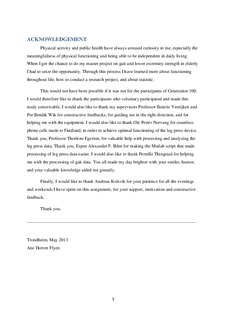The Association between Gait Speed and Lower Extremity Strength in Elderly
Master thesis
Permanent lenke
http://hdl.handle.net/11250/271548Utgivelsesdato
2013Metadata
Vis full innførselSamlinger
Sammendrag
Background: Gait speed has been strongly associated with functioning and also found to be a global index of functioning in elderly. Similarly, low general muscle strength has been associated with physical inactivity and functional impairment.
Aim: The aim of this study was to investigate whether there is an association between gait speed and lower extremity strength in elderly.
Design: This was a cross-sectional study.
Methods: 489 community-dwelling women and men (71.5 ± 5 yrs) filled out a questionnaire for background information, and were tested for gait speed and lower extremity strength. Gait speed was measured while participants walked in their preferred and fast gait speed on an electronic GaitRite walking mat. Lower extremity strength was tested with the Sit-to-stand performance test and leg press.
Results: Significant, low to strong, positive associations were found between both gait speed levels and the Sit-to-stand parameters in both genders (p < 0.0005). Fast gait speed was strongly associated with peak V in both women and men (p < 0.0005). There was found low to moderate associations between gait in both speed levels and leg press parameters in both genders (p < 0.0005). Strong associations were also found between gait speed and step length in both speed levels (p <0.0005) and between peak force (F) and peak rate of force development (RFD) in leg press in both genders (p < 0.0005).
Conclusion: Gait speed is associated with lower extremity strength in elderly, with increase in gait speed associated with increase in lower extremity strength. When gait speed increases, step length and cadence increases as well. Men walked faster and had stronger lower extremity strength than women. Future studies should investigate the direction of the association between gait speed and lower extremity strength through a prospective study, to see whether it is possible to maintain good function in gait by conduct lower extremity strength training or if it is more effective to focus on gait speed to maintain good lower extremity strength.
Key Words: Gait speed, step length, cadence, lower extremity strength, functional strength, isometric strength, leg strength, leg press, sit-to-stand test and elderly.
